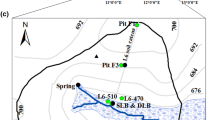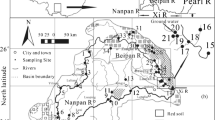Abstract
Export of dissolved organic carbon (DOC) from forested catchmentsis governed by competing processes of production, decomposition, sorptionand flushing. To examine the sources of DOC, carbon isotopes (14Cand 13C) were analyzed in DOC from surface waters, groundwatersand soils in a small forested catchment on the Canadian Shield in centralOntario. A significant fraction (greater than 50%) of DOCin major inflows to the lake is composed of carbon incorporated into organicmatter, solubilized and flushed into the stream within the last 40 years. Incontrast, 14C in groundwater DOC was old indicating extensiverecycling of forest floor derived organic carbon in the soil column beforeelution to groundwater in the lower B and C soil horizons. A small uplandbasin had a wide range in 14C from old groundwater values atbaseflow under dry basin conditions to relatively modern values during highflow or wetter antecedent conditions. Wetlands export mainly recently fixedcarbon with little seasonal range. DOC in streams entering the small lakemay be composed of two pools; an older recalcitrant pool delivered bygroundwater and a young labile pool derived from recent organic matter.The relative proportion of these two pools changes seasonally due thechanges in the water flowpaths and organic carbon dynamics. Althoughchanges in local climate (temperature and/or precipitation) may alterthe relative proportions of the old and young pools, the older pool islikely to be more refractory to sedimentation and decomposition in thelake setting. Delivery of older pool DOC from the catchment andsusceptibility of this older pool to photochemical decomposition mayconsequently be important in governing the minimum DOC concentrationlimit in lakes.
Similar content being viewed by others
References
Aravena R, Schiff SL, Trumbore SE, Dillon PJ & Elgood R (1992) Evaluating dissolved inorganic carbon cycling in a forested lake watershed using carbon isotopes. Radiocarbon 34: 636–645
ai]Aravena R & Wassenaar LI (1993) Dissolved organic carbon and methane in a regional confined aquifer: Evidence for associated subsurface sources. Applied Geochem. 8: 483–493
ai]Boutton PW, Wong WW, Hachey DL, Lee LS, Cabrera MP & Klein PD (1983) Comparison of quartz and pyrex tubes for combustion of organic samples for stable carbon isotope analysis. Anal. Chem. 55: 1832–1833
Bunting JM, Warner BG & Aravena R (1996) Late quaternary vegetation dynamics and hydroseral development in a Thuja occidentallisswamp in southern Ontario. Can. J. Earth Sciences (in press)
Burcholadze AA, Chudy M, Eristavi IV, Pagava SV, Povinec P, Sivo A & Togonidaze GI (1989) Anthropogenic 14C variations in atmospheric CO2 and wines. Radiocarbon 31: 771–776
Charman D, Aravena R & Warner B (1993) Carbon dynamics in a forested peatland in northeastern Ontario, Canada. J. of Ecol. 82: 55–62
Cronan CS (1985) Comparative effects of precipitation acidity on three forest soils: Carbon cycling responses. Plant Soil 88: 101–112
Dankevy SN, Schiff SL, English MC & Dillon PJ (1991) Groundwater flow and chemistry in a small acid-stressed subcatchment in the Canadian Shield. In: Proc. of the NHRI Symposium on Groundwater Contamination. National Hydrologic Research Institute, Saskatoon, Canada
De Haan H (1993) Solar UV-light penetration and photodegradation of humic substances lake water. Limnol. Oceano. 38: 1072–1076
Devito KJ (1994) Hydrologic control of sulphur dynamics in headwater wetlands of the Canadian Shield. PhD Thesis. York University, Toronto, Canada. 210 pp
Dillon PJ & Molot L (1997) Dissolved organic and inorganic carbon mass balances in central Ontario lakes. Biogeochem. 36: 29–42
Dillon PJ, Nicholls KH, Scheider WA, Yan ND & Jeffries DS (1986) Lakeshore Capacity Study: Trophic Status. Ontario Ministry of Municipal Affairs. Toronto Canada. 89 pp
Druffel ERM, Williams PM, Robertson K, Griffin S, Jull AJT, Donahue D, Toolin L & Linick TW(1989) Radiocarbon in dissolved organic and inorganic carbon from the central North Pacific. Radiocarbon. 31: 523–532
Eshleman KN & Hemond HF (1985) The role of organic acids in the acid-base status of surface waters at Bickford watershed, Massachusetts. Water Resources Res. 21: 1503–1510
Hinton MJ, Schiff S & English M (1994) Examining the contributions of glacial till water top storm runoff using two-and three-component hydrograph separations. Water Resources. Res. 30: 983–993
Hinton MJ, Schiff S & English MC(1997a) The significance of storms for the concentration and export of dissolved organic carbon from two Precambrian Shield catchments. Biogeochem. 36: 67–88
Hinton MJ, Schiff S & English MC (1997b) Sources and flowpaths of dissolved organic carbon during storms in two Precambrian Shield catchments. Biogeochem. (submitted)
Hobbie JE & Wetzel RG (1992) Microbial control of dissolved organic carbon in lakes-Research for the future. Hydrobiologia 229: 169–180
Hudson RJM, Gherini SA & Goldstein RA (1994) Modeling the global carbon cycle: Nitrogen fertilization of the terrestrial biosphere and the "missing" CO2 sink. Global Biogeochem. Cycles 8: 307–333
Jardine PM, Wilson GV, McCarthy JFM, Luxmoore RJ, Taylor DL & Zelazny LW (1990) Hydrogeochemical processes controlling the transport of dissolved organic carbon through a forested hillslope. J. Contam. Hydrol. 6: 3–19
Jeffries DS & Snyder WR (1983) Geology and geochemistry of the Muskoka-Haliburton study area. Dorset Research Centre Ontario Ministry of Environment Data Report DR 83/2: 101 pp
Johnson NM, Likens GE, Bormann FH, Fisher DW & Pierce RS (1969) A working model for the variation in stream water chemistry at the Hubbard Brook Experimental Forest, New Hampshire. Water Resources. Res. 5: 1353–1363
Lean D & Scully N (1995) Spectral irradiance and photochemical reactions in lakes. Biogeochem. (submitted)
MacLean RA (1993) The role of vadose zone in the generation of runoff from a headwater basin in the Canadian Shield. MA thesis. Wilfrid Laurier University, Canada. 158 pp
McDowell WH & Fisher SG (1976) Autumnal processing of dissolved organic matter in a small woodland stream ecosystem. Ecol. 57: 561–569
Mewhinney E, Aravena R & Schiff S (1995) The hydrology of two contrasting small boreal forest wetlands in Northwestern Ontario. Intern. Assoc. Hydrogeologists Congress, Edmonton, Canada. June 1995
Meyer JL & Tate CM(1983) The effects of watershed disturbance on dissolved organic carbon dynamics of a stream. Ecol. 64: 33–44
Moore TR (1989) Dynamics of dissolved organic carbon in forested and disturbed catchments, Westland, New Zealand. 1. Maimai. Water Resour. Res. 25: 1321–1330
Murphy EM, Davis SN, Long A, Donahue D & Jull AJT (1989) Characterization and isotopic composition of organic and inorganic carbon in the Milk River Aquifer. Water Resources Res. 25: 1893–1905
O'Leary MH (1988) Carbon isotopes in photosynthesis. Bioscience 38: 328–336 OME (1983) Ontario Ministry of Environment. Handbook of analytical methods for environmental samples, Lab. Serv. Branch, Rexdale, Ont.
Salonen K (1995) The significance of light degradation of DOM in humic lakes in Finland. Biogeochem. (submitted)
Schiff SL, Aravena R, Trumbore SE & Dillon PJ (1990) Dissolved organic carbon cycling in forested watersheds: A carbon isotope approach. Water Resources Res. 26: 2949–2957
Schindler DW & Curtis PJ (1997) The role of DOC in protecting freshwaters subjected to climatic warming and acidification from UV exposure. Biogeochem. 36: 1–8
Schindler DW et al. (1997) Climate-induced changes in the dissolved organic carbon budgets of boreal lakes. Biogeochem. 36: 9–28
Schindler DW, Bayley SE, Curtis PJ, Parker BR, Stainton MP & Kelly CA (1992) Natural and man-caused factors affecting the abundance and cycling of dissolved organic substances in Precambrian Shield lakes. Hydrobiologia 229: 1–21
Scully NM & Lean DRS (1994) The attenuation of ultraviolet light in temperate lakes. Arch. Hydrobiol. 43: 135–144
Stuiver M & Polach HA (1977) Discussion: Reporting of 14C data. Radiocarbon. 19: 355–363
Thurman EM (1985) Organic geochemistry of natural waters. Martinus Nijhoff/Dr W. Junk Publishers, 497 pp
Trumbore SE (1993) Comparison of carbon dynamics in two soils using measurements of radiocarbon in pre-and post-bomb soils. Global Biogeochem. Cycles 7: 275–290
Trumbore SE, Schiff SL, Aravena R & Elgood R (1992) Sources and transformation of dissolved organic carbon in the Harp Lake forested catchment: The role of soils. Radiocarbon. 34: 626–635
Vance GF & David MB (1991) Forest soil response to acid and salt additions of sulfate: III. Solubilization and composition of dissolved organic carbon. Soil Science 151: 297–305
Vogel JS, Nelson DE & Southon RJ (1987). 14C background levels in an accelerator mass spectrometry system. Radiocarbon. 29: 323–333
Wassenaar L, Aravena IR, Hendrey MJ & Fritz P (1991) Radiocarbon in dissolved organic carbon-a potential groundwater dating method: Case studies from western Canada. Water Resources Res. 27: 1975–1986
Author information
Authors and Affiliations
Rights and permissions
About this article
Cite this article
Schiff, S., Aravena, R., Trumbore, S. et al. Export of DOC from forested catchments on the Precambrian Shield of Central Ontario: Clues from 13C and 14C. Biogeochemistry 36, 43–65 (1997). https://doi.org/10.1023/A:1005744131385
Issue Date:
DOI: https://doi.org/10.1023/A:1005744131385




